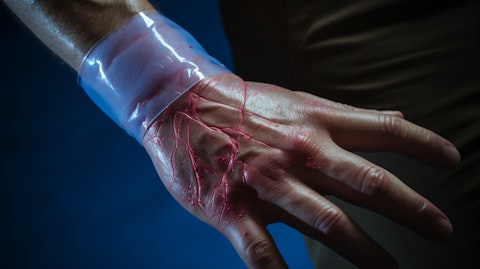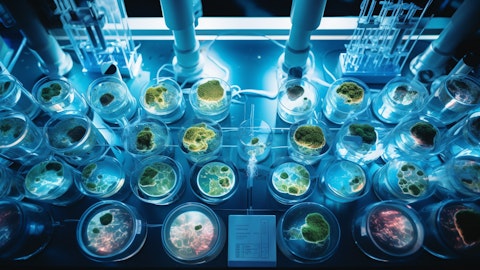NEXGEL, Inc. (NASDAQ:NXGL) Q2 2025 Earnings Call Transcript August 12, 2025
NEXGEL, Inc. misses on earnings expectations. Reported EPS is $-0.09 EPS, expectations were $-0.01.
Operator: Good afternoon. I’ll be your conference operator today. At this time, I’d like to welcome everyone to NEXGEL’s Second Quarter 2025 Financial Results Conference Call. I’ll now turn the call over to Valter Pinto, Managing Director of KCSA Strategic Communications for introductions. Please go ahead, sir.
Valter Pinto: Thank you, operator. Good afternoon, and welcome, everyone, to NEXGEL’s Second Quarter 2025 Financial Results Conference Call. I’m joined today by Adam Levy, Chief Executive Officer; and Joe McGuire, Chief Financial Officer. Before we begin, I’d like to remind everyone that statements made during today’s conference call may be deemed forward-looking statements within the meaning of the safe harbor of the Private Securities Litigation Reform Act of 1995, and actual results may differ materially due to a variety of risks, uncertainties and other factors. For a detailed discussion of some of the ongoing risks and uncertainties in the company’s business, I refer you to the press release issued this evening and filed with the SEC on Form 8-K as well as the company’s reports filed periodically with the SEC.
The company disclaims any intention or obligation to update or revise any forward-looking statements, whether as a result of new information, future events or otherwise, unless otherwise required by law. Also, during the course of today’s call, we will refer to certain non-GAAP financial measures. Reconciliations of the non-GAAP to GAAP financial measures and certain additional information are also included in today’s press release. With that, it’s my pleasure to turn the call over to Mr. Adam Levy. Adam, please go ahead.
Adam R. Levy: Thank you, Walter, and thank you, everyone, for joining us today to discuss our second quarter of 2025 financial and operating results. For the second quarter of 2025, we reported a strong revenue and gross margin period with a continued decline of our adjusted EBITDA loss as we head into what we expect to be a seasonally strong second half of the year. Revenue during the quarter was approximately $2.9 million, an increase of 100% year-over-year and up slightly sequentially. The year-over-year growth was led by growth in both consumer demand for our branded products and new agreements in contract manufacturing. Gross margins for the quarter came in at 43.6%, more than double the 20.3% we reported in Q2 2024 and an increased sequentially from 42.4%.
Our loss continued narrowing in the second quarter as well. EBITDA and adjusted EBITDA loss narrowed to negative $530,000 and negative $420,000, respectively, compared to negative $760,000 and negative $790,000 for the same period last year. I’ll now provide an update on both our contract manufacturing and consumer branded products businesses, starting with contract manufacturing. This segment of our business has played a pivotal role in our growth, led by increased demand from existing customers as well as the successful onboarding of several new global corporations. For the second quarter, contract manufacturing revenue increased to $863,000 from approximately $425,000 in Q2 of 2024, a 103% year-over-year increase. Our ongoing relationship with Cintas remains strong with our SilverSeal product continuing to be included in their wound care kits.
We began shipping initial orders to Cintas in Q4 and Q1 of this year, and reorders began in late Q2. Due to the initial shipments, Q2 sales were lower than we expect to have going forward. The reorder pattern is solid for Q3. This partnership reflects the consistent value our advanced hydrogel technology brings to Cintas’ customers and underscores our commitment to long-term recurring commercial relationships. The institutional review board study conducted under FDA guidelines and funded by our partner, Vanalay U.S. Inc., is complete, and we are waiting on final data to be published. This 30-patient clinical trial evaluated the use of our hydrogels when applied prior to laser hair removal treatments. The primary goal of the study was to assess its efficacy in reducing the release of carcinogenic plume during these procedures.
We are constantly seeing new applications for our hydrogels. For example, in May, we signed an agreement with iRhythm, a publicly listed company on the NASDAQ and a leading digital health care company that creates trusted solutions that detect, predict and prevent disease to supply our hydrogels as part of their Zio® ECG heart monitor. Zio® is a single-use ECG heart monitor that provides a continuous single-channel recording for up to 14 days. The monitor is worn on the patient’s upper left chest and it features NEXGEL’s hydrogel adhesive wings for security, comfortable placement throughout the daily usage and easy removal. After the conclusion of the 14-day monitoring period, the patient simply removes the device and mails it back to iRhythm for analysis.
The integration of our hydrogels into iRhythm’s Zio® heart monitor, showcases another impactful application for our skin-friendly dermatologically safe technology. We look forward to growing this relationship going forward as they continue to commercialize their product. There are also many other opportunities like this that we are evaluating. We expect contract manufacturing and white label to continue being a major driver of our expansion and success moving forward. Turning our attention to consumer products. This segment revenue increased 95% year-over-year for the second quarter of 2025, driven by growth across the entire brand portfolio. In late Q2, we began to see strong performance from the first of the new Silly George product launches we previewed earlier this year.

In addition to the continued growth of our core lash offerings, we are excited to introduce our expanded beauty line. The upcoming collection includes 5 new shades of lip gloss, the hydrating lip mask and under- eye patches crafted with our own proprietary hydrogel, each designed to enhance our brand’s commitment to innovative high-quality beauty solutions. These additions are expected to make a meaningful contribution to our revenue in Q3 and Q4, and reflect continued success of our product innovations. Similarly, Kenkoderm will double the size of its product portfolio with the launch of new products. Kenkoderm is an established brand that provides its customers with high-quality skin care products to relieve the symptoms of psoriasis. The new product line will expand into solutions for eczema, tapping into an even larger market opportunity for a brand that is leveraging its strong reputation as a leader in sensitive skin care.
MEDAGEL has expanded its product line with the launch of several new offerings, including the SilverSeal wound and burn kit, which was just released this week and its moist burn pads. We have also just received approval from Health Canada to begin to sell SilverSeal in that territory. Lastly, we could not be more excited about our expanding partnership with STADA, a European leader in consumer health. Building on the strong performance of Histasolv, we recently amended our agreement to broaden the collaboration considerably. Together with STADA, we anticipate introducing additional products as early as Q4 2025 with several more slated for the first half of 2026. This next phase of the partnership includes the planned launch of additional digestive enzyme formulas and skin care solutions targeting scars and stretch marks, products we are now positioned to bring to the North American market.
As part of the expanded relationship, STADA has provided $1 million in non-dilutive funding to support the upcoming product launches and marketing initiatives. With our current cash on hand, the $1 million from STADA and the $1.05 million which we recently raised, we now have sufficient cash to support our upcoming growth initiatives. We remain confident in our previously issued guidance for 2025 of $13 million in revenue and to achieve positive EBITDA during the year. Before I turn the call over to Joe to review our second quarter financial results. I am excited to welcome Steve Ciardiello, Chief Accounting Officer at Shutterstock to our Board of Directors. Steve brings deep expertise in accounting systems and financial oversight, and we believe his strategic guidance will be a strong asset as we enter this next phase of our growth.
Thank you to our shareholders for your ongoing confidence in our team and mission. Your support remains essential as we continue to execute on our growth strategy and build long-term value together. I’d now like to turn the call over to Joe McGuire, our Chief Financial Officer.
Joseph F. McGuire: Thank you, Adam. Today, I’ll review our key financial results for Q2 2025. For the second quarter of 2025, revenue totaled $2.88 million an increase of 100.3% as compared to $1.44 million for the second quarter of 2024. The increase in overall revenues was primarily due to sales growth in both contract manufacturing and branded products. Cost of revenues totaled $1.63 million for the second quarter of 2025 as compared to $1.15 million for the second quarter of 2024. The increase in cost of revenues is primarily aligned with sales of branded consumer products as Silly George was acquired midway through the comparable 2024 time period. Gross profit totaled $1.26 million for the second quarter of 2025 as compared to a gross profit of $0.29 million for the second quarter of 2024.
Gross profit margin for the second quarter of 2025 was 43.6% as compared to 20.3% for the second quarter of 2024. The increase of $0.97 million in gross profit on a year-over-year basis was primarily due to both an increase in contract manufacturing and an increase in consumer branded products given the acquisition of Silly George midway through the comparable period. Selling, general and administrative expenses totaled $1.89 million for the second quarter of 2025 as compared to $1.27 million for the second quarter of 2024. The increase year-over-year was attributable to increases in compensation and benefits, share-based compensation, advertising, professional and consulting fees, other fees and investor and shareholder services which was partly offset by a decrease in depreciation and amortization.
EBITDA, a non-GAAP financial measure totaled a loss of $530,000 for the second quarter of 2025 as compared to a loss of $760,000 for the second quarter of 2024. Adjusted EBITDA, a non-GAAP financial measure totaled a loss of $420,000 for the second quarter of 2025 as compared to a loss of $790,000 for the second quarter of 2024. Net loss attributable to NEXGEL’s stockholders for the second quarter of 2025 was $670,000 as compared to a net loss of $890,000 for the second quarter of 2024. As of June 30, 2025, the company held a cash balance of approximately $0.73 million. Subsequent to the quarter end, the company received a $1 million non-dilutive capital from STADA to support upcoming product launches and marketing efforts. Additionally, the company closed on a $1.05 million registered direct offering and concurrent private placement.
As of August 12, NEXGEL had 8,067,580 shares of common stock outstanding. I would now like to open the call for questions. Operator?
Q&A Session
Follow Nexgel Inc. (NASDAQ:NXGL)
Follow Nexgel Inc. (NASDAQ:NXGL)
Receive real-time insider trading and news alerts
Operator: [Operator Instructions] We’ll take our first question from Naz Rahman with Maxim Group.
Nazibur Rahman: Congrats on the progress. Just a few. I wanted to just start on the STADA partnership and the additional capital you got. Could you talk a little bit about what you think the market opportunities are for the upcoming launches? And I guess, how does that compare to Histasolv?
Adam R. Levy: Yes, so Histasolv is a digestive enzyme targeting histamine sensitivity. The upcoming enzymes that we’ll be putting out — now by the way, Histasolv is a very large product in Europe where they’ve been working and understanding enzymes a lot longer than they have here. It’s a over $25 million a year product in Europe. It’s growing very nicely for us here. But histamine sensitivity only affects between 2.5% to 3% of the population. The upcoming enzymes, gluten, for example, dairy, fructose, we also have an extra strength, vegan version of Histasolv coming out. Those are much larger markets. So we’re excited for them. It also gives us the leverage of a brand, very difficult to begin to contemplate retail when you only have one product and one enzyme. But as we can build out a suite of solutions, that’s sort of our go- to-market strategy to get into retail as well.
Nazibur Rahman: Got it. That was helpful. And I guess on that point, in terms of your retail strategy, do you have any updates on when you could potentially enter the retail market? And also just kind of on that point, are there any thoughts about consolidating all the various brands under, I guess, like one brand to enter the retail space? Or is that currently not an option?
Adam R. Levy: Well, we — so I’ll take the second question first. So the brands have their own unique identity based on the solutions and the markets that they serve, right? It really doesn’t make sense to combine wound care or blister products with Silly George Beauty, right? They have their own identity and they have their own brand. So I don’t really see that happening, although we will be putting more products. For example, the STADA Health products are sold under the [ MetaGel ] brand store. So there, we’re kind of combining the exposure because it makes sense. It doesn’t really make sense on the Silly George side. As far as retail goes, we are in talks with several large retailers now mostly on a private label basis because the product that there’s most interest in is SilverSeal.
And again, difficult to put one product on the shelf and have the advertising budget to support one product. It’s very risky. So we’re more discussing private label at this time, but it takes probably 8 to 10 months away from anything significant being actually in stores. It’s just the length of time that these planograms take.
Nazibur Rahman: Got it. That was very helpful. Obviously, NEXGEL as a whole signed a lot of partnerships and engaging a lot of partnership agreements over the last couple of years. I guess on the manufacturing side, could you kind of talk a little bit about, I guess, how much manufacturing capacity you have at this point to supply more partners? Or I guess how much slack do you have in that system currently?
Adam R. Levy: Yes. So driving the gel sales is really one of the secrets to our profitability because the plant utilization is still very low for a manufacturing facility, much better than the 4% it was when I walked in the door, but still only at about in the high teens maybe. So we can still make lots and lots and lots of gel, that’s not really the issue. We need to onboard more of these customers. And as you know, this can be a 1.5- to 2-year process. Now we expect to announce more as the year develops. We expect to bring more on board because it’s constantly feeding pipeline. We’re not able to do a press release, but we did file an 8-K on the iRhythm becoming a new customer, and there’ll be more customers like that. They didn’t allow us to do a press release, but they did allow us to talk about them and use their logo in our deck.
So we thank them for that. But that’s just one example of another one that’s in the pipeline, and there are several more in the pipeline.
Nazibur Rahman: Yes. That’s helpful. But I guess on that point, could you talk, I guess, about what do you think the revenue economic opportunity for the iRhythm partnership is?
Adam R. Levy: So that partnership, they’re talking about — I don’t want to — I’m under NDA, so I really can’t talk about the total number of units. But we think about the different opportunities that we have, there’s the smaller customers that come in. There are the large medical device customers that grow at a very steady CAGR. Most of them, the opportunities are somewhere between $300,000 to $800,000, $1 million a year, and they fall in that range. I would put multiples such as Owens & Minor and iRhythm. There are several companies in that category. And then they’re the ones that could be super impactful. And those are the ones where you’re literally the razor blade in the device. Obviously, the AbbVie project, which has been delayed a couple of times, which is why I didn’t even speak about it because we’re waiting for that to get a little more clarity, although I do speak to them regularly, and they are pushing ahead with the project and assure me that it is coming out.
But those are the opportunities, AbbVie and a couple of others in the pipeline that could be really impactful revenue, millions and millions of dollars.
Nazibur Rahman: Got it. If I could just ask one more question. I know this is an ever-evolving conversation regarding tariffs. But I guess based on everything that’s happened thus far, has, I guess, NEXGEL been impacted or affected by tariffs either beneficially or negatively? Or do you still see that happening based on your understanding of the tariff situation currently?
Adam R. Levy: So a little bit of both. There’s a mild negative impact on the margins in Silly George and in some of the products that do come from overseas, although it hasn’t been as bad as we were worried about, so it really has not been super impactful. On the positive side, we have seen a lot more interest in our gels from domestic companies. But again, there’s an onboarding process associated with that. So it hasn’t translated yet into a lot of revenues in Q2 because it really kind of started in Q1. But we think it will, there will be some of these customers that do convert and help us on that side as we move into later Q3 and Q4 and Q1 of next year.
Nazibur Rahman: Got it. Congrats on the progress.
Operator: We’ll take our next question from [ Christopher Spencer ].
Unidentified Analyst: I was just going to ask about the AbbVie partnership, but you sort of covered that as kind of waiting for their product to come out because you guys have been talking about that for a while and didn’t know where the status was on that.
Adam R. Levy: We have. They had some delays in their process with a different — had nothing to do with us with a different vendor that was working on their console. They’ve told me that they got rid of that vendor some time ago. They brought it all in-house. I do check in with them, obviously, it’s very important to us. I mean that was something we were counting on to be in full swing by now, and we haven’t even started. But I’ll call up and blow in a call going. Nothing disastrous has happened, right? And there’s no new updates and they assure me that they’re back on schedule, on the new schedule and that things are progressing. So fingers crossed.
Unidentified Analyst: They don’t have any set schedule. They’re just waiting for FDA and putting everything together?
Adam R. Levy: Well, yes, their schedule was basically — they told us it would be a 10- to 12-month delay from the first quarter of last year. So I’m looking at it starting first quarter of 2026. There is a chance we might get some small orders before that. But really, I’m looking at this as being a 2026 event at this point. And this has been delayed twice. The original time line, and we built a facility around this in part was July of 2024 when they first approached us in 2022. So we’ve been working with them a long time. Obviously, they have a very, very deep financial commitment at $550 million for the device. So I still believe it’s coming out. They believe it’s coming out, but it has been frustrating that it’s not out already.
Operator: We’ll take our next question from [ Chris Bitiosky ].
Unidentified Analyst: You mentioned a new product from Silly George that started selling this quarter. Can you tell us more about it?
Adam R. Levy: Sure. So Silly George has a line of — we actually released in Q2 at the very end, a couple of variations on our lashes, a 75 Lash, which is really a Pop-On Lash, but it almost covers the entire eye and then you accent it with the smaller lashes. We also made Focus Packs. So what we’re finding from our customer feedback is that they were saying, “Oh, we love your 60 Pack, but I use mostly these sizes. I wish I could buy a box of just these, and then I could use the 60 Pack as fill in, I end up wasting some products.” So we created a small Focus Pack of 24 lashes that are all the same size, and those have been very popular. They worked really well for us as well because we have higher margin on the smaller packages so there is a little bit of cannibalism there, although we haven’t seen very much.
The 60 Pack sales are only down about 4%, and we added about 17% or 18% new sales from these packs, plus they have better margins. So that’s been very successful. We are then going to be releasing at the end of this month, beginning first week of September, 5 shades of lip gloss, a lip and eye mask, under-eye are coming in Q4 made from our hydrogel. There’s a new mascara coming out. So there’s a whole series of products that will be coming out in the second half of this year that we’re pretty excited about.
Unidentified Analyst: Okay. That’s good to hear. And any comment on those Silly George sales thus far in the present quarter? Are they improving with the summer seasonally?
Adam R. Levy: Yes. I mean the summer — I’m not sure summer seasonally is a season for us. It’s really the fourth quarter that is the big one. Back- to-school is big, too. But the sales are very strong. We’re not seeing any weakness in the consumer. We look for that, especially with all the talk around the financial markets. July was the biggest month of the year so far, and we hope that we can carry that momentum through the rest of the third quarter and obviously into the new products into the fourth quarter. But so far, all positive.
Unidentified Analyst: Okay. Good to hear. And that $1 million non-dilutive financing, how is that — how did that happen technically? Is it the loan? Is it a prepayment?
Adam R. Levy: It’s in advance. So it’s in advance against future profits. There’s no recourse to have it repaid. It’s kind of like — they used to do this a lot when I was in the music industry years ago. You’d advance an artist money to go make the album. They’d make the album. If the album sold, the record label would recoup the money. If it didn’t sell or it wasn’t profitable, there was no recourse back to the artist. It’s similar to that, right? They wanted to invest in our partnership. They knew that NEXGEL alone was trying to become profitable. And so creating all of the materials and the advertising and everything to launch 9 products, which are now on the schedule, would not have been a good thing for us to have to pay for it.
So we were worried about that. They said, don’t worry about it. We’ll give you the money. We’ll advance the money to the partnership. You pay us back when the partnership is profitable. Otherwise, don’t worry about it. And we can pay back as little as 5% out of the profits towards the repayment. So they gave us very, very generous terms, no interest, nothing like that.
Operator: [Operator Instructions] We’ll take our next question from Kirtan Patel.
Kirtan Patel: This is Kirtan. My question is, I know earlier you kind of touch up on the capacity for the manufacturing. So my question is, what is the company currently operating at in terms of both the contract manufacturing as well the branded products?
Adam R. Levy: So a lot of our branded products are made by us, so that would be part of our capacity. The capacity down in Texas, they have lots of room to expand because we are waiting for AbbVie. So we obviously are overbuilt down there. And we’re probably still below — well below 20% up in Langhorne to manufacture gel. So capacity is not the issue right now. We just need to keep filling the pipeline and having the business grow as it’s been growing.
Kirtan Patel: Okay. Got it. So if the company grows at a current trajectory rates and in the future, if you need to increase the capacity, do you have plan in place in case you need to increase that?
Adam R. Levy: Yes, we’ve talked about it. So we have plenty of space down in Texas. It’s the converting and packaging facility is literally in a cow field. So we have lots of room to expand. We just did an expansion there, and there’s more room and more acreage to expand if we have to. There’s lots of extra room in our clean room, we overbuilt it because we didn’t know what sorts of machines. So we can easily expand there. We’ve talked about what happens if some of these bigger customers really roll in. If 2 or 3 of them really hit within 2 or 3 years, we would need a plan to sort of increase our capacity at that point. That would be a golden problem to have, but we do have a plan for that. We do know how to build these plants.
Kirtan Patel: Got it. And my next question is regarding the cash position. So I’ve been noticing that the company is running very close to the operating expenses and been raising cash very diligently through dilution. And I admire that you’re not doing any significant dilutions over the years. But my question is, let’s say, in case of like a global recession or something like that, given that current events surrounding tariffs and long-term high interest rates, do you — have you been taking into consideration in case of something like that were to happen? How would the company would be able to survive through that?
Adam R. Levy: Yes, you’re always thinking about that. I mean, in some ways, I always think a recession is the best time to build the business because you don’t — you’re not living in a fantasy world of everything being great. You’d have to cut back your cost, you’d have to reexamine your margins. There’s a lot that you have to do if we start to see that slow down, fortunately, we’re not seeing that yet. But yes, that is something that we do think about all the time. Fortunately, our consumer products are fairly high margin. So when you have a fairly high-margin business, things like the tariffs, and we’ve had this discussion when the tariffs first came into play, obviously, 145% tariff with China would be a problem. But when you start talking about 25%, 30% and your cost of goods is about 17%.
So you’re really kind of raising that 17% up to 21%. You might have to pass a little bit of that on, but it isn’t super destructive to the business that has 85% or 83% gross margins. The real cost is in advertising.
Kirtan Patel: Got it. So is your plan to basically target mainly the bigger companies who is looking into the contract manufacturing compared to consumers?
Adam R. Levy: Well, no, we have all sorts of size customers, but the bigger companies are the ones that have the robust medical device programs that really need the medical-grade biocompatible hydrogels, right? So that’s where the opportunity has been. The opportunity has been with the larger companies because they are the ones making the devices that are going through 510(k) through the FDA that have the more stringent requirements, and that’s where we shine.
Kirtan Patel: Okay. Got it. Again, congratulations on your continued growth. Hopefully, positive EBITDA by end of the year as planned.
Adam R. Levy: Yes. That’s our target.
Operator: We will take our next question from [ David Blancher ].
Unidentified Analyst: I have a question in your prior investor presentations, you had stuff about surgical drapes. I know that’s been taken off. And I’ve seen some research reports that are forecasting the launch of NEXDrape and NEXDerm over the next couple of years. I just wanted to see if that was accurate or something that…
Adam R. Levy: Yes. So if you noticed we added a gentleman by the name of Kip Crecca to our Scientific Advisory Board, specifically to work on our Drape Program. We sort of thought about it and said, you know what, going after at this stage, something that we have to sell to another company and developing that surgical [ in size ] drape, maybe we put that on the back burner for a second because we had some issues as well with trying to extrude a drape that thin. It would have required significant investments in new pumps and dyes, which we have so many things going on. I didn’t think was the best use of our cash. But what we have identified is that there’s an opportunity in, for example, cataract surgical drapes, which are very simple.
And the idea of what Kip is going to try and go out and market is, can we sell our adhesives to a company that makes that drape to have a gentle to the skin for an elderly audience. So we now become just a material supplier again. That means we’re not doing any 510(k) stuff. That means we’re giving it to somebody who already has a market built in. We kind of think that’s lower-hanging fruit, so we’ve sort of pivoted to that. But we still think there’s a big opportunity, particularly for NEXDerm, a gentle adhesive that could hold an IV in place that could maybe be impregnated with Silver that would help prevent MRSA and staff infections in a hospital. We think is a great idea, it’s just that we can only do so many things at the same time and some opportunities have presented themselves to us that is where we’re putting our resources right now.
Unidentified Analyst: Okay. One more question. If you were to rank maybe a top 3 or top 5 of your partnerships, could you give that to us? Is it something that’s already been only things that have been announced? Or are there some things that you’re working on that would make your top 3 or 5?
Adam R. Levy: Well, there’s definitely a couple of things working on, one in particular that would definitely make the top 3. So we always have big fish in the pipeline, whether they come through or not is something that we work on and we hope for, but we definitely have some potential opportunities there. A couple of them that would be in the top 7 and certainly one that would be in the top 3 or 4. So yes, those are there. As of the ones we have right now, I mean, they’re different. Cintas is a wonderful partnership, very steady, replenishment, a terrific partner. You may have noticed that we just got — I think we announced that we just got cleared in Canada with SilverSeal. So we’ll be having discussions about expanding that relationship, there’s a lot to be done there.
AbbVie obviously still has huge potential, been disappointing with the delays, but that doesn’t mean it’s not one of the biggest opportunities, if not the biggest opportunity that’s out there. And then there’s a lot of steady customers like the Owens & Minor and the iRhythm, and those are all great companies. And we’re very excited about STADA. STADA has a wealth of products that if we do well with these first 9 that are coming out or so, then the entire catalog is open to us, and that’s pretty exciting, too. So there’s a lot of good stuff on the horizon.
Operator: We’ll take our next question from [ Jeff Memira ].
Unidentified Analyst: Quick question, of the $13 million you project for revenue this year, what percentage of that revenue will be Silly George?
Adam R. Levy: Probably $6, $6.5 million.
Unidentified Analyst: $6.5 million of the $13 million. So almost half will be Silly George?
Adam R. Levy: Yes. Yes. Silly George is doing quite well.
Operator: [Operator Instructions] And there are no further questions on the line at this time. This does conclude today’s program. We thank you all for your participation. You may now disconnect.
Follow Nexgel Inc. (NASDAQ:NXGL)
Follow Nexgel Inc. (NASDAQ:NXGL)
Receive real-time insider trading and news alerts




